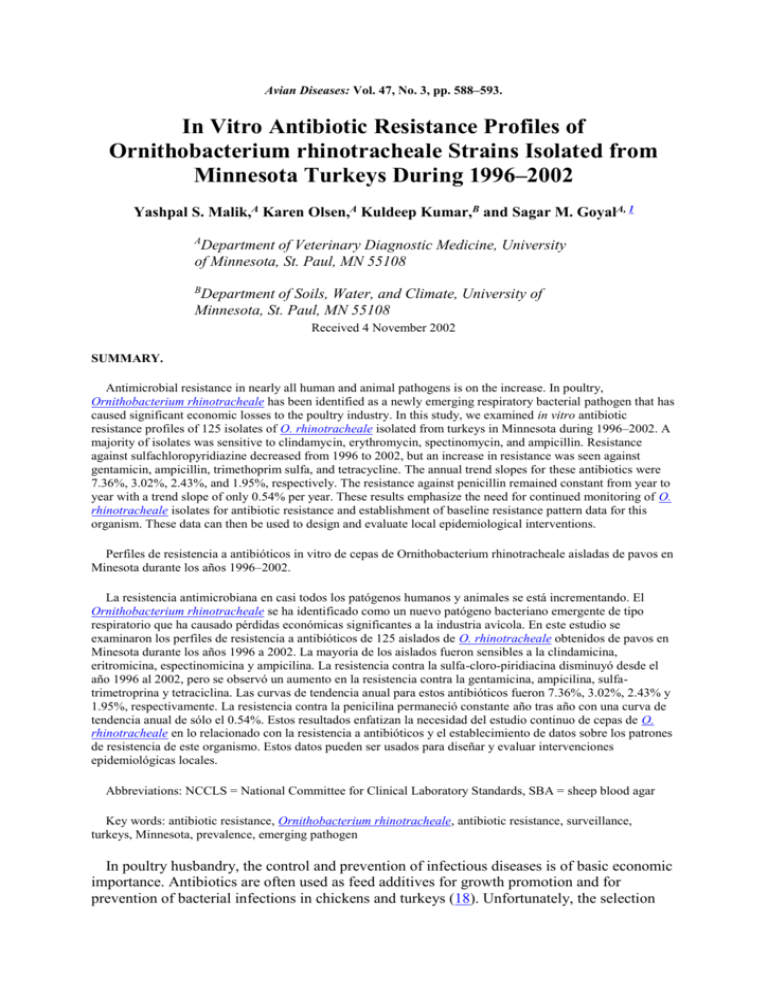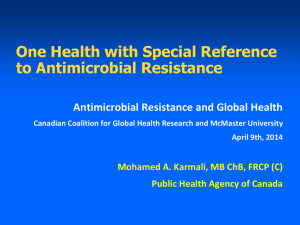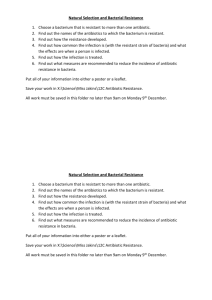Avian Diseases: Vol
advertisement

Avian Diseases: Vol. 47, No. 3, pp. 588–593. In Vitro Antibiotic Resistance Profiles of Ornithobacterium rhinotracheale Strains Isolated from Minnesota Turkeys During 1996–2002 Yashpal S. Malik,A Karen Olsen,A Kuldeep Kumar,B and Sagar M. GoyalA, 1 A Department of Veterinary Diagnostic Medicine, University of Minnesota, St. Paul, MN 55108 B Department of Soils, Water, and Climate, University of Minnesota, St. Paul, MN 55108 Received 4 November 2002 SUMMARY. Antimicrobial resistance in nearly all human and animal pathogens is on the increase. In poultry, Ornithobacterium rhinotracheale has been identified as a newly emerging respiratory bacterial pathogen that has caused significant economic losses to the poultry industry. In this study, we examined in vitro antibiotic resistance profiles of 125 isolates of O. rhinotracheale isolated from turkeys in Minnesota during 1996–2002. A majority of isolates was sensitive to clindamycin, erythromycin, spectinomycin, and ampicillin. Resistance against sulfachloropyridiazine decreased from 1996 to 2002, but an increase in resistance was seen against gentamicin, ampicillin, trimethoprim sulfa, and tetracycline. The annual trend slopes for these antibiotics were 7.36%, 3.02%, 2.43%, and 1.95%, respectively. The resistance against penicillin remained constant from year to year with a trend slope of only 0.54% per year. These results emphasize the need for continued monitoring of O. rhinotracheale isolates for antibiotic resistance and establishment of baseline resistance pattern data for this organism. These data can then be used to design and evaluate local epidemiological interventions. Perfiles de resistencia a antibióticos in vitro de cepas de Ornithobacterium rhinotracheale aisladas de pavos en Minesota durante los años 1996–2002. La resistencia antimicrobiana en casi todos los patógenos humanos y animales se está incrementando. El Ornithobacterium rhinotracheale se ha identificado como un nuevo patógeno bacteriano emergente de tipo respiratorio que ha causado pérdidas económicas significantes a la industria avícola. En este estudio se examinaron los perfiles de resistencia a antibióticos de 125 aislados de O. rhinotracheale obtenidos de pavos en Minesota durante los años 1996 a 2002. La mayoría de los aislados fueron sensibles a la clindamicina, eritromicina, espectinomicina y ampicilina. La resistencia contra la sulfa-cloro-piridiacina disminuyó desde el año 1996 al 2002, pero se observó un aumento en la resistencia contra la gentamicina, ampicilina, sulfatrimetroprina y tetraciclina. Las curvas de tendencia anual para estos antibióticos fueron 7.36%, 3.02%, 2.43% y 1.95%, respectivamente. La resistencia contra la penicilina permaneció constante año tras año con una curva de tendencia anual de sólo el 0.54%. Estos resultados enfatizan la necesidad del estudio continuo de cepas de O. rhinotracheale en lo relacionado con la resistencia a antibióticos y el establecimiento de datos sobre los patrones de resistencia de este organismo. Estos datos pueden ser usados para diseñar y evaluar intervenciones epidemiológicas locales. Abbreviations: NCCLS = National Committee for Clinical Laboratory Standards, SBA = sheep blood agar Key words: antibiotic resistance, Ornithobacterium rhinotracheale, antibiotic resistance, surveillance, turkeys, Minnesota, prevalence, emerging pathogen In poultry husbandry, the control and prevention of infectious diseases is of basic economic importance. Antibiotics are often used as feed additives for growth promotion and for prevention of bacterial infections in chickens and turkeys (18). Unfortunately, the selection pressure exerted by antibiotics may lead to an increase in antibiotic resistance in both the pathogens and the fecal microflora of poultry (23). Drug resistant bacteria from poultry may also be transmitted to humans either directly or via food. The dissemination of resistant bacteria from turkeys to turkey farmers, slaughterers, and area residents and from chickens to human handlers has been reported (10,17,22). The development of resistance to commonly used antimicrobials may result in increased costs of care due to the use of alternative antimicrobials, which are often more costly. In recent years, Ornithobacterium rhinotracheale has become an important pathogen of turkeys (6,7,19). This is a pleomorphic, gram negative, rod shaped bacterium causing mortality, growth suppression, prostration, decreased feed intake, severe weight loss, coughing, and decreased egg production in affected birds (1,2). Ornithobacterium rhinotracheale has also been isolated from turkeys without clinical signs (15). In some cases, mortality may reach up to 10%. In addition, condemnation at the processing plant may also result in economic losses to the producers. This organism was first isolated from broilers with respiratory disease in Germany in 1981. Since then, it has been reported from turkeys in South Africa, the Netherlands, France, Israel, Belgium, Hungary, the United Kingdom, and the United States (2,4,6,8,19,20). In late 1995, O. rhinotracheale was first isolated from market age tom turkeys in Minnesota and Wisconsin (14). The control of O. rhinotracheale infections is important to minimize economic losses in poultry flocks. During recent years, O. rhinotracheale infections have become more common, and treatment with antibiotics has become less effective (24). It is important, therefore, to evaluate the efficacy of antimicrobial drugs in current use and to determine patterns of antimicrobial resistance. The analysis of data over a period of time will display trends in antimicrobial resistance, and these data should be useful in investigating the epidemiology of drug resistance. In this study, we describe the antimicrobial resistance profiles of O. rhinotracheale strains isolated from turkeys in Minnesota during 1996–2002. MATERIALS AND METHODS Return to TOC Source of samples Tracheal swabs, lung tissues, and sinus exudate swabs from turkeys with respiratory illness are routinely submitted to the Minnesota Veterinary Diagnostic Laboratory, St. Paul, MN, for disease diagnosis. These samples were initially inoculated on sheep blood agar (SBA) followed by incubation in 5% CO2 atmosphere at 37 C for 24 hr. Suspect colonies were subjected to standard biochemical tests. Oxidase positive, catalase negative, and CO2 dependent isolates that showed no color change on triple sugar iron agar were further tested with API-ZYM system (BioMeriuex-France, Lyon, France) for confirmation. Antibiotic susceptibility Since a standard protocol for antibiotic sensitivity tests for O. rhinotracheale does not exist, the method described by the National Committee for Clinical Laboratory Standards (NCCLS) for fastidious gram-negative organisms was followed (12). Colonies were taken directly from an overnight blood agar culture plate and suspended in Mueller Hinton broth. The suspension was swabbed on the surface of blood Mueller Hinton agar followed by the application of antibiotic discs: clindamycin, erythromycin, spectinomycin, ampicillin, sulfadimethoxine, trimethoprim sulfa, gentamicin, ceftiofur, sulfachloro-pyridiazine, enrofloxacin, penicillin, and tetracycline. Antibiotic resistance or susceptibility was determined using the criteria for fastidious gram-negative organisms as established by NCCLS. Antibiotics trend graphs were plotted using sigma plot software. RESULTS Return to TOC During the period under report, a total of 125 samples yielded O. rhinotracheale. The isolation rate of the organism continued to increase (from 8 to 46) from 1996 to 2000, except for 1997 when only one isolate was obtained. During 2001 and 2002, the number of organisms isolated was 27 and 7, respectively. As shown in Table 1 , none of the isolates was resistant to clindamycin and only one of the 125 isolates was resistant to erythromycin. Data on spectinomycin from 1996 to 1999 indicated that all isolates were susceptible in 1996 and 1999 but 80% of them were resistant in 1998. Resistance to ampicillin was also low (from 0% to 10%), except that 44.4% of the isolates were resistant in 2001. The trend graph showed an increase in ampicillin resistance from 1996 to 2001 with a slope of 3.02% per year (Fig. 1 ). In 2002, however, none of the isolates was resistant to ampicillin. Complete resistance to sulfadimethoxine was seen in isolates from 1996 to 2001 with an exception in 2002, when 85.7% of the isolates were resistant with a decreasing slope of 1.6% per year (Table 1 , Fig. 1 ). An increasing trend of resistance to gentamicin and trimethoprim sulfa was observed with slopes of 7.36% and 2.43% per year, respectively (Fig. 1 ). Although resistance to ceftiofur increased from 1999 to 2001, none of the seven isolates in 2002 was resistant to ceftiofur. Sulfachloropyridiazine was evaluated in 1996, 1998, and 2002 only. The isolates showed high resistance to sulfachloropyridiazine in 1996 (75.0%) but were less resistant in 1998 (20.0%) and 2002 (28.6%). The rate of resistance to enrofloxacin remained constant from 1999 to 2001 (47.8%–59.3%) but decreased to 0.00% in 2002. The resistance to penicillin was also constant from year to year; the trend graph shows an increase of only 0.54% per year from 1996 to 2002. A slow increase was seen in resistance to tetracycline (25.0% in 1996 to 42.9% in 2002) with a slope of 1.95% per year (Fig. 1 ). DISCUSSION Return to TOC Antibiotics are commonly used to treat and prevent infectious diseases and for growth promotion in the poultry industry. Indiscriminate use of these antibiotics, however, may lead to antibiotic resistance in both pathogens and resident microflora. In fact, the development of antibiotic resistance in several poultry pathogens has been well documented. Studies on antibiotic resistance in O. rhinotracheale, however, are sparse, although this is an important emerging respiratory pathogen of poultry. In this study, we evaluated 12 antimicrobials against O. rhinotracheale isolated from turkeys during 1996 to 2002. All isolates from 1999 to 2002 were susceptible to clindamycin in vitro. The results obtained with erythromycin in this study are in agreement with earlier studies in which O. rhinotracheale was found to be very susceptible to erythromycin in vitro (3,9,11,13). However, these results are in contrast to those of van Veen et al. (24), in which O. rhinotracheale was found to be the least sensitive to erythromycin. Our results on spectinomycin are also in accordance with earlier reports, in which O. rhinotracheale isolates were shown to be highly susceptible to spectinomycin (11,16). However, the appearance of spectinomycin resistance in 80% of the isolates in 1998 is more in agreement with the findings of Devriese et al. (7). Almost solid resistance against sulfadimethoxine is in accordance with an earlier study (7) in which most isolates of O. rhinotracheale were found to be resistant to sulfadimethoxine. The results of resistance against trimethoprim sulfa are also in accordance with earlier studies (9,11,21), in which most isolates of O. rhinotracheale showed consistent resistance to trimethoprim sulfa. However, these results are in contrast to those of van Veen et al. (24) in which all isolates of O. rhinotracheale were found to be very susceptible to this antibiotic. An increasing trend of resistance against gentamicin in this study is similar to that reported in earlier studies (3,9,11,13,24). The resistance to ceftiofur increased from 1999 to 2001, which is in contrast to the findings of van Veen et al. (24), who showed a very high rate of susceptibility to ceftiofur. However, our results of 2002, in which all isolates were susceptible to ceftiofur, are in accordance with van Veen et al. (24). The rate of resistance (47.00% to 59.00%) against enrofloxacin from 1999 to 2001 was similar to that reported in O. rhinotracheale from Germany and the Netherlands (9,21). Complete susceptibility to enrofloxacin in 2002 is in accordance with findings from France, Belgium, and Israel (3,7,24). Low and consistent resistance to penicillin has been reported earlier (7,11,13), and the data on tetracycline resistance are also in accordance with earlier findings (3,5,7,11,13,24). In summary, O. rhinotracheale isolated in Minnesota between 1996 and 2002 have been steadily becoming resistant to gentamicin, ampicillin, tetracycline, and trimethoprim sulfa. These data on antibiotic resistance should be eventually helpful in planning strategies for the control of O. rhinotracheale infections in turkeys. REFERENCES Return to TOC 1. Back, A., K. V. Nagaraja, D. A. Halvorson, and G. Rajashekara. Ornithobacterium rhinotracheale infections in turkeys. In: Proc. 47th North Central Avian Diseases Conference. pp. 48–50. 1996. 2. Bensink, J. C., and F. P. Botham. Antibiotic resistant coliform bacilli isolated from freshly slaughtered poultry and from chilled poultry at retail outlets. Aust. Vet. J. 60:80–83. 1983. 3. Bock, R., P. Freidlin, S. Tomer, M. Manoim, A. Inbar, A. Frommer, E. Berman, and S. Pokamunsky. Ornithobacterium rhinotracheale: current status in Israel. In: Proc. First International Symposium on Turkey Diseases, Berlin. pp. 151–162. 1998. 4. Charlton, B., S. Channing-Santiago, A. Bickford, C. Cardona, R. Chin, G. Cooper, R. Droual, J. Jeffrey, C. Meteyer, H. Shivparasad, and R. Walker. Preliminary characterization of a pleomorphic gram-negative rod associated with avian respiratory disease. J. Vet. Diag. Invest. 5:47–51. 1993. 5. Chin, R., and R. Droual. Ornithobacterium rhinotracheale infection. In: Diseases of poultry, 10th ed. B. W. Calnek, ed. Iowa State University Press, Ames, IA. pp. 1012–1015. 1997. 6. De Rosa, M., R. Droual, R. P. Chin, H. L. Shivprasad, and R. L. Walker. Ornithobacterium rhinotracheale infection in turkey breeders. Avian Dis. 40:865–874. 1996. 7. Devriese, L. A., J. Hommez, P. Vandame, K. Kersters, and F. Haesebrouck. In vitro antibiotic sensitivity of Ornithobacterium rhinotracheale strains from poultry and wild birds. Vet. Rec. 137:435–436. 1995. 8. Hafez, H. M. Respiratory disease condition in turkeys caused by Ornithobacterium rhinotracheale: clinical signs, diagnostics and therapy. In: Proc. 43rd Western Poultry Disease Conference, Sacramento, CA. pp. 113–114. 1994. 9. Hafez, H. M. Current status on the role of Ornithobacterium rhinotracheale (ORT) in respiratory disease complexes in poultry. Arch. Gefliigelkunde. 61:208–211. 1996. 10. Levy, S. B., G. B. Fitzgerald, and A. B. Macone. Spread of antibiotic resistant plasmids from chicken to chicken and from chicken to man. Nature. 260:40–42. 1976. 11. Nagaraja, K. V., A. Back, S. Sprenger, G. Rajashekara, and D. A. Halvorson. Tissue distribution post infection and antimicrobial sensitivity of Ornithobacterium rhinotracheale. In: Proc. 47th Western Poultry Disease Conference, Sacramento, CA. pp. 57–60. 1998. 12. National Committee for Clinical Laboratory Standards. Performance standards for antimicrobial disk dilution susceptibility tests for bacteria isolated from animals,. 2nd ed., vol. 22, No. 6. NCCLS approved standard, Wayne, PA. pp. M31–A2. 2002. 13. Odor, E., M. Salem, C. Pope, B. Sample, M. Primm, K. Vance, and M. Murphy. Case report: isolation of Ornithobacterium rhinotracheale from commercial broiler flocks on the Delmarva Peninsula. Avian Dis. 41:257–260. 1997. 14. Roepke, D. C. Field observation of Ornithobacterium rhinotracheale infections in integrated turkey operation. In: Proc. Turkey ORT Symposium, Minneapolis, MN. pp. 45–46. 1996. 15. Roepke, D. C., A. Back, D. P. Shaw, K. V. Nagaraja, S. J. Sprenger, and D. A. Halvorson. Isolation and identification of Ornithobacterium rhinotracheale from commercial turkey flocks in the upper Midwest. Avian Dis. 42:219–221. 1998. 16. Roger, M. F., and J. Leorat. AI origine de troubles respiratories chez la dinde: Ornithobacterium rhinotracheale est mieux maitrise. Filiere Evicole Juin. 62–63. 1997. 17. Stobberingh, E., A. E. Van den Bogaard, N. London, D. Christel, T. Janetta, and R. Willems. Enterococci with glycopeptide resistance in turkeys, turkey farmers, turkey slaughterers and (sub) urban residents in South of the Netherlands: evidence for transmission of Vancomycin resistance from animals to humans?. Antimicrob. Agents Chemother. 43:2215–2221. 1999. 18. Swezey, J. L., B. B. Baldwin, and M. C. Bromel. Effects of oxytetracycline as a turkey feed additive. Poult. Sci. 60:738–743. 1981. 19. Tanyi, J. Isolation of Ornithobacterium rhinotracheale from chicken hens and turkeys showing respiratory signs. Magy Allatorv. Lapja. 50:328–330. 1996. 20. Travers, A. Concomitant Ornithobacterium rhinotracheale and New Castle Disease infections in broilers in South Africa. Avian Dis. 40:488–490. 1996. 21. Van Beek, P., P. Van Empel, G. Vanden Bosch, P. Storm, J. Bongers, and J. Dupreez. Ademhalingsproblemen, groeivertraging en grewrichstontsteking bij kalkoenen en vleeskuikens door een Pasteurella achtige bacterie: Ornithobacterium rhinotracheale of “Taxon 28.”. Tijdschr. Diergeneeskunde. 119:99–101. 1994. 22. Van den Bogaard, A. E., N. London, C. Driessen, and E. Stobberingh. Antibiotic resistance of fecal Escherichia coli in poultry, poultry farmers and poultry slaughterers. J. Antimicrob. Chemother. 47:763–771. 2001. 23. Van den Bogaard, A. E., and E. Stobberingh. Antibiotic usage in animals–impact on bacterial resistance and public health. Drugs. 58:589–607. 1999. 24. van Veen, L., E. Hartman, and T. Fabri. In vitro antibiotic sensitivity of strains of Ornithobacterium rhinotracheale isolated in the Netherlands between 1996 and 1999. Vet. Rec. 149:611–613. 2001. 1 Corresponding author. Department of Veterinary Diagnostic Medicine, College of Veterinary Medicine, University of Minnesota, 1333 Gortner Avenue, St. Paul, MN 55108 FIGURES Return to TOC Click on thumbnail for full-sized image. Fig. 1. Trend graph of six antibiotics against O. rhinotracheale 1996–2002. Each graph shows regression and slope values for the antibiotic in question TABLES Return to TOC Table 1. Percent of antibiotic resistant O. rhinotracheale isolated from turkeys during 1996–2002.A






